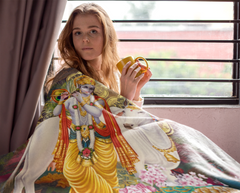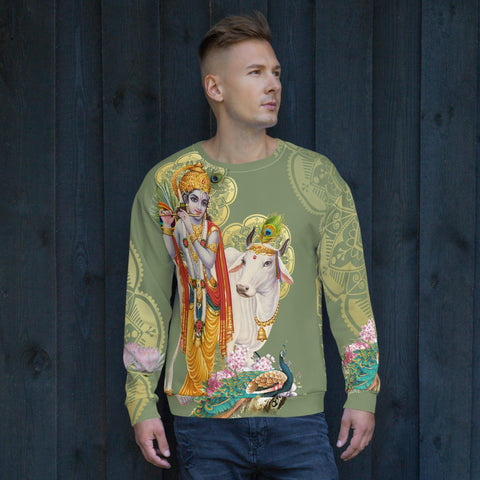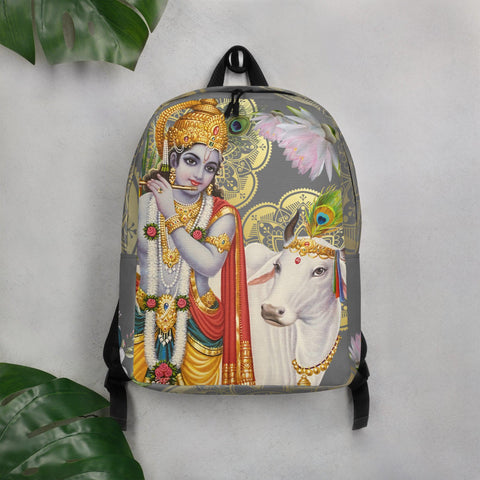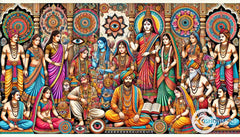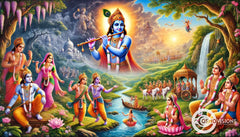Radha Krishna: The Eternal Love Story of Radha and Krishna
Posted by Massimiliano Geraci

Many people search for stories that embody pure, unconditional love. Krishna's life, including his upbringing in the remote village of Vrindavan and his charming personality, sets the stage for such tales. The tale of Radha and Krishna from Hinduism represents just that—a love profound completely pure and eternal. This ethereal duo’s story is about romance and offers deep spiritual insights, making it an intriguing subject for those interested in anthropology, spirituality, and Indic art.
One key fact to note is that the narrative of hindu Goddess Radha and Shri Krishna has been celebrated through various forms over centuries—be it in sacred texts like the Bhagavata Purana or through the emotional expressions found in Jayadeva’s Gita Govinda.
Our article aims to unfold this celestial love story while exploring its significant impact on Vaishnavism and how devotees express their bhakti towards this divine couple. Through exploring places like Vrindavan, rituals, and the philosophy behind their devotion, we offer a guide to understanding Radha Krishna’s timeless legacy.
Discover more as you read on.
What is the significance of Radha and Krishna in Hinduism?
Transitioning from the introduction, we explore Hindu spirituality and devotion, focusing on Radha and Krishna. This divine pair personifies ultimate love, transcending mere human affection to embody a holy fusion of souls.
Their story is celebrated in texts such as the Bhagavata Purana and Brahma Vaivarta Purana, revered scriptures that lay foundations for Vaishnavism’s theological beliefs. Radha’s unconditional devotion to Krishna elevates her status beyond that of a simple deity to symbolize the human soul’s intense longing for union with the divine.
In this context, Radha and Krishna are not just supreme deities worshipped across temples in India; they are a testament to unyielding faith and love guiding devotees to spiritual enlightenment.
The depiction of their eternal bond through sacred arts—singing, dancing (Raslila), madhubani paintings—resonates profoundly within Gaudiya Vaishnavism and across diverse Hindu culture.
It challenges followers to explore depths of their own devotional practices toward Sri Krishna while contemplating Radha’s essential role as his most ardent admirer and consort, illustrating an exemplary pathway to achieving divine love. Through devotion to Radha and Sri Krishna, one finds the highest expression of spiritual longing fulfilled.

Understanding the divine love of Radha and Krishna
The divine love of Radha and Krishna represents an epitome of spiritual devotion in Hinduism, transcending the mere physical to signify a deeper, eternal connection. This sacred relationship is celebrated throughout various Hindu texts, including the Bhagavata Purana and Brahma Vaivarta Purana, where their love is depicted as the ultimate form of bhakti (devotion to God).
Krishna's life, including his upbringing in the remote village of Vrindavan, his charming personality as a young man and accomplished flutist, and the bittersweet love affair with Radha, adds depth to their divine relationship. The story of Radha and Krishna showcases how divine love can lead to spiritual awakening, making it a central theme in Vaishnavism.
Radha’s unconditional love for Lord Krishna, despite never marrying Him according to traditional scriptures, illustrates the human soul intense longing for union with the Divine. In this narrative, Krishna reciprocates Radha’s affection not through worldly commitments but by establishing her as an eternal consort in His celestial abode Goloka.
Their story emphasizes that true devotion lies beyond material attachments and social norms. Understanding their role within Vaishnavism helps explore how this divine couple guides seekers toward enlightenment through love.
The place of Radha and Krishna in Vaishnavism
Vaishnavism holds Radha and Krishna at its spiritual core, embracing them as the epitome of divine love and devotion. This tradition sees Krishna not just as an avatar of Lord Vishnu but as Svayam Bhagavan, the Supreme Lord Himself, with Radha considered his eternal consort and the embodiment of Shakti. In the Nimbarka Sampradaya, the worship of Sri Krishna and Radha as the unified divine couple is central, emphasizing their eternal significance and the dualistic monism philosophy of Nimbarka.
Their relationship symbolizes the highest form of bhakti (devotion) in Vaishnavism and inspires followers to pursue a path of love towards supreme God that transcends the physical world. Through sacred texts like the Bhagavata Purana and Brahma Vaivarta Purana, devotees learn about their intimate pastimes in Vrindavan, further solidifying their central role in this spiritual path.
In addition to being worshipped individually for their divine qualities, together, Radha and Krishna’s worship is pivotal within various traditions such as Gaudiya Vaishnavism popularized by Chaitanya Mahaprabhu.
His teachings illuminate how their love story is not merely a tale from ancient scriptures but a living example guiding practitioners toward experiencing profound spiritual emotions (bhavas) themselves.
Temples dedicated to Radha Krishna around India, particularly in Vrindavan where they shared many moments, serve as focal points for these expressions of devotion. Here, art forms like dance (rasa lila) reenact their celestial love affair allowing devotees to immerse themselves completely into recalling Radha-Krishna’s eternal playfulness (lilas).

Depictions in sacred texts like Bhagavata Purana and Brahma Vaivarta Purana
Bhagavata Purana and Brahma Vaivarta Purana, sacred texts in Hinduism, vividly portray the divine love story of Radha and Krishna. These ancient scriptures provide detailed descriptions of the celestial bond between Radha and Krishna, emphasizing their eternal connection. They also depict Krishna's life, including his upbringing in the remote village of Vrindavan, his charming personality as a young man and accomplished flutist, and his bittersweet love affair with Radha.
The Bhagavata Purana specifically delves into the passionate love shared by Radha and Krishna, shedding light on their extraordinary relationship. Similarly, the Brahma Vaivarta Purana offers profound insights into the mystical nature of their love, capturing its essence through enchanting narratives.
Both these sacred texts serve as invaluable sources for understanding the timeless adoration between Radha and Krishna.
The Bhagavata Purana and Brahma Vaivarta Purana not only encapsulate the fervent devotion of Radha towards Krishna but also elucidate his reciprocation of that affection unreservedly.
Through their compelling verses and captivating stories, these revered texts illuminate the enduring saga of divine love that continues to inspire devotees across generations.
How is Krishna worshipped as a deity?
Krishna is worshipped as a supreme deity through various forms of devotional practices across different traditions within Hinduism. Devotees express their reverence for Sri Krishna through singing bhajans, reciting the Bhagavad Gita, and adorning his idols with flowers and garlands in temples.
The significance of Krishna’s love for Radha is emphasized in worship, highlighting the divine bond between them. Celebrations like Janmashtami, commemorating Krishna’s birth, and rituals in Vrindavan, the land of Krishna’s pastimes with Radha, serve as expressions of devotion toward this beloved deity.
In addition to these celebrations and rituals that honor Krishna’s divine presence, devotees engage in various forms of Bhakti towards him. These worship practices reflect the deep spiritual connection that individuals seek to establish with Lord Krishna by expressing their love and devotion towards him.
The Radha Madhab Temple and Radha Vallabh Sampradaya are prominent centers where devotees engage in such acts of veneration towards both Radha and Krishna.
Forms of Krishna worship in different traditions
Krishna and radha worship takes various forms across different traditions within Hinduism. In the Nimbarka Sampradaya, devotees revere Krishna and Radha equally, considering them as the ultimate divine couple symbolizing love and devotion. The significance of Sri Krishna in the Nimbarka Sampradaya is profound, as it centers on the worship of Sri Radha Krishna as the unified divine couple, emphasizing their eternal significance and the philosophical position of Nimbarka.
On the other hand, in Pushtimarg tradition, there is a strong focus on Shrinathji - an infant manifestation of Krishna - where worship revolves around seva (service) and bhakti (devotion).
The Swaminarayan Sampradaya emphasizes devotion to Lord Swaminarayan as an incarnation of Krishna, with elaborate rituals and celebrations marking key events in his life. Swaminarayan explained that Krishna appears in various forms. When he is with Radha, he is revered as the supreme lord under the name Radha-Krishna; with Rukmini, he is known as Lakshmi-Narayana. Each tradition offers unique perspectives on how to cultivate a deep connection with Lord Krishna through worship.
In Vaishnavism, specifically among Gaudiya Vaishnavas, the practice of chanting the Hare Krishna mantra plays a central role in devotion. This form of congregational singing is known as kirtan and is considered integral to expressing love for Radha and Krishna.
Celebrations such as Janmashtami (Krishna’s birth anniversary) provide opportunities for devotees to immerse themselves in devotional activities, further strengthening their bond with Lord Krishna.
Significance of Krishna's love for Radha in worship
Krishna’s love for Radha holds immense significance in Hindu worship, portraying the divine union and the embodiment of pure devotion. Krishna's life, including his upbringing in the remote village of Vrindavan, his charming personality as a young man and accomplished flutist, and his bittersweet love affair with Radha, is central to this narrative. The profound bond between Krishna and Radha represents and exemplifies the quintessence of love, serving as a symbol for devotees to emulate in their spiritual journey.
This divine connection is central to the practice of Bhakti towards Krishna, with Radha representing the epitome of unwavering devotion and selfless love. The adoration and reverence for Radha’s love for Krishna are encapsulated in various forms of worship, including devotional songs, dance performances, and intricate rituals that celebrate their eternal bond.
The enduring love story of Radha and Krishna has inspired countless devotees to seek spiritual fulfillment through deep emotional resonance with their divine romance. In Vaishnavism, worshippers embrace this narrative as a profound testament to unconditional devotion.
Their love story transcends time and space, underscoring the timeless nature of true love amidst worldly complexities. Through heartfelt adoration for Radha’s boundless affection towards Krishna, devotees find solace and inspiration in their own pursuit of spiritual connectedness.
Moving on to “The Story of Radha and Krishna”…
Celebrations and rituals in Vrindavan
The city of Vrindavan, nestled on the banks of the Yamuna River in Uttar Pradesh, is an epitome of devotion and celebration for followers of Radha and Krishna. Krishna's life, including his upbringing in the remote village of Vrindavan, his charming personality as a young man and accomplished flutist, and the bittersweet love affair with Radha, is central to the cultural and spiritual fabric of the city. Every year during Holi, the Festival of Colors, devotees joyously reenact the divine love story by splashing vibrant hues on each other.
The Ras Leela dance drama performed in Vrindavan during Kartik Purnima showcases a mesmerizing spectacle that brings to life the enchanting tales of Radha and Krishna’s eternal love.
Devotees also partake in traditional rituals such as “Parikrama”, a circumambulation around Vrindavan’s sacred sites associated with Radha and Krishna. These practices bring about a sense of spiritual closeness to the divine couple, fostering a deep connection between devotees and their beloved deities amidst an atmosphere charged with unwavering devotion.
Additionally, during Janmashtami – Lord Krishna’s birthday – elaborate processions traverse through Vrindavan, heightening the fervor and faith among locals and pilgrims alike.
The boisterous chants magnify throughout Vrindavan as people come together to commemorate this auspicious occasion with unyielding zeal.

What is the story of Radha and Krishna?
The story of Radha and Krishna originates from ancient Hindu sacred texts, such as the Bhagavata Purana and Brahma Vaivarta Purana. Krishna's life, including his upbringing in the remote village of Vrindavan, his charming personality as a young man and accomplished flutist, and his bittersweet love affair with Radha, is central to these narratives. Radha is revered as the eternal consort of Krishna, representing divine love and devotion.
Their profound bond symbolizes the spiritual relationship between humanity and the divine. In these narratives, Radha’s unwavering love for Krishna embodies selfless devotion, while Krishna’s endearing affection for Radha epitomizes the reciprocation of pure love.
Radha-Krishna folklore has been eloquently described in works by renowned poet Jayadeva, shaping their mythos with emotional depth and spiritual significance. The story chronicles early life and their idyllic moments in Vrindavan, painting a vivid picture of their timeless love amidst pastoral landscapes.
This captivating tale transcends cultural boundaries, embodying universal themes of unconditional love and spiritual connection between devotee supreme goddess and deity.
The origins of their love story in sacred texts
The origins of Radha and Krishna’s love story can be traced back to sacred texts such as the Bhagavata Purana and the Brahma Vaivarta Purana. These texts also describe Krishna's life, including his upbringing in the remote village of Vrindavan, his charming personality as a young man and accomplished flutist, and his bittersweet love affair with Radha. These ancient scriptures depict the divine love shared between Radha and Krishna, emphasizing their eternal bond and spiritual union.
The Bhagavata Purana, in particular, describes their profound relationship, illustrating Radha as the embodiment of pure devotion towards Krishna. The mention of Radha’s unwavering affection for Krishna in these revered texts underscores the depth of their connection and its significance within Hinduism.
These sacred writings not only highlight the romantic love aspect of Radha and Krishna’s bond but also symbolize their eternal love as a metaphor for the divine union between devotee and deity.
The stories recounted in these texts serve to inspire a deep sense of devotion among followers, emphasizing the transcendental nature of their relationship with profound implications for spiritual seekers.
Role of Radha as the consort of Krishna
Transitioning from the origins of their love story in sacred texts, we delve into the essential role of Radha as the chief consort and of Krishna. Krishna's life, including his upbringing in the remote village of Vrindavan, his charming personality as a young man and accomplished flutist, and the bittersweet love affair with Radha, is central to understanding their relationship. Radha is not merely a consort but is often regarded as Krishna’s eternal beloved, embodying unconditional devotion and divine love.
In Hindu theology, her significance is unparalleled, symbolizing the utmost level of devotion (Bhakti) towards Lord Krishna. Described in sacred texts such as Brahma Vaivarta Purana and Devi Bhagavata Purana, Radha’s intimate relationship with Krishna exemplifies the worshipers’ pursuit of spiritual union and the divine embodiment of love.
Radha holds an elevated position not only as Krishna’s consort but also symbolizes Shakti – feminine energy that underpins creation within Hindu cosmology. This deep symbolism resonates throughout various forms of Bhakti towards Radha Krishna, observed in temples like Radha Madhab Temple and practiced within the Radha Vallabh Sampradaya.
The multifaceted nature of her character speaks volumes about both human emotions and our connection to divinity through intense human love, for God.
Influence of Jayadeva's works on the story of Radha Krishna
Jayadeva, a prominent 12th-century Indian poet, made an indelible mark on the story of Radha Krishna through his composition “Gita Govinda.” Jayadeva's works vividly depict Krishna's life, including his upbringing in Vrindavan, his charming personality, and his love affair with Radha. This lyrical poem deeply influenced the portrayal of Radha and Krishna’s divine love.
Jayadeva’s poetic verses delved into the tender emotions and spiritual significance of their relationship, centering on themes of separation and union. The timeless work not only enriched the cultural landscape but also augmented the emotional depth and poetic imagery associated with Radha and Krishna’s love in Hindu mythology.
The Gita Govinda continues to inspire various forms of art, music, dance, and literature dedicated to Radha-Krishna devotion across India. Its influence is evident in classical dance performances like Odissi and Bharatanatyam that depict episodes from the divine love story.
Furthermore, its verses have been a wellspring for countless devotional compositions known as ‘Bhajans’ sung by devotees during religious ceremonies or personal worship sessions.
Moving further into our exploration, let’s delve into how devotees express their devotion to Radha and Krishna.
How do devotees express their devotion to Radha and Krishna?
Devotees express their devotion to Radha and Krishna through various forms of Bhakti, including singing devotional songs, dancing in ecstasy, and reciting sacred poetry. Practices in Radha Madhab Temple and Radha Vallabh Sampradaya actively involve the worship of Radha and Sri Krishna, emphasizing the divine love between them.
The role of Gopis, the cowherd girls who symbolize unconditional devotion, is crucial in the worship of Radha Krishna. Their unwavering love for Krishna serves as a model for devotees’ dedication to the divine couple.
The forms of Bhakti towards Radha Krishna are deeply rooted in spiritual traditions that have been meticulously passed down through generations. Devotees engage in rituals that are tailored towards expressing profound reverence and adoration for the eternal love shared by Radha and Krishna.
This dedication underpins the ever-evolving realm of devotion found amongst anthropology, spirituality, and indios art lovers.
Leading into “Why is Vrindavan considered significant in the worship of Radha and Krishna?

Forms of Bhakti towards Radha Krishna
Devotees express their devotion to Radha Krishna through various forms of Bhakti, such as Kirtan, Sankirtan, and Japa. In the Radha Madhab Temple and within the Radha Vallabh Sampradaya, devotees immerse themselves in singing devotional songs and chanting mantras dedicated to the divine couple. The Nimbarka Sampradaya emphasizes the worship of Sri Krsna and his consort Radha, highlighting their eternal significance as the unified divine couple.
The role of Gopis is crucial in the worship of Radha Krishna, symbolizing selfless love and surrender towards the divine. Their dedication serves as an inspiration for devotees striving for a deeper connection with Radha Krishna.
Moving forward to “Why is Vrindavan considered significant in the worship of Radha and Krishna?
Practices in Radha Madhab Temple and Radha Vallabh Sampradaya
Devotees express their devotion to Radha and Krishna through various practices in the Radha Madhab Temple and Radha Vallabh Sampradaya. The significance of Sri Krsna is central to these practices, emphasizing the worship of the divine couple Radha and Krishna. These ancient traditions encompass rituals, prayers, and festivals dedicated to honoring the eternal love between Radha and Krishna.
The followers of this path engage in deep meditation on the divine couple, often accompanied by devotional songs and recitations from sacred texts such as Bhagavata Purana. Moreover, artistic expressions like dance and drama are integral to these practices, serving as a form of spiritual offering to Radha and Krishna.
The worshipers meticulously adhere to prescribed customs passed down through generations, seeking more than just religious fulfillment; they aim for an intimate spiritual connection with the divine.
Through these time-honored practices at the Radha Madhab Temple and within the Radha Vallabh Sampradaya community, devotees immerse themselves in a realm of unwavering devotion that brings them closer to the profound love shared by Radha and Krishna.
Moving forward…
Role of Gopis in the worship of Radha Krishna
Gopis play a pivotal role in the worship of Radha Krishna, embodying deep devotion and pure love. Krishna's life, including his upbringing in the remote village of Vrindavan, his charming personality, and his relationship with the Gopis, is central to understanding this devotion. Their unwavering dedication to Krishna symbolizes the intense spiritual connection between devotees and the divine.
Through their selfless actions and undying affection, Gopis exemplify the essence of true Bhakti towards Radha and Krishna. Their portrayal in sacred texts such as Bhagavata Purana underscores their significance as devoted followers who resonate with countless worshippers seeking to emulate their profound love for the divine couple.
Devotees express reverence through various practices inspired by Gopis’ adoration for Radha Krishna, highlighting their crucial influence on religious observances. The timeless legacy of Gopi bhava continues to inspire devotees worldwide, underscoring its enduring impact within Hindu spirituality and cultural traditions.
Why is Vrindavan considered significant in the worship of Radha and Krishna?
Vrindavan holds profound historical and spiritual importance in the worship of Radha and Krishna. Krishna's life, including his upbringing in the remote village of Vrindavan, his charming personality as a young man and accomplished flutist, and his bittersweet love affair with Radha, is central to the city's significance. The city is synonymous with their divine love, attracting millions of devotees annually.
Its significance lies in being the stage for the eternal love story between Radha and Krishna, as detailed in sacred texts like Brahma Vaivarta Purana and Bhagavata Purana. Devotees flock to Vrindavan to visit shrines dedicated to Radha-Krishna lore, such as the iconic Banke Bihari Temple and Govind Dev Ji Temple, which have been integral places of worship for centuries.
These temples are at the heart of celebrations that epitomize devotion to Radha Krishna, attracting pilgrims from all corners of India.
The cultural customs observed by followers in Vrindavan underscore its tremendous impact on the worship of Radha and Krishna. Every aspect of life there seems centered around this eternal love story – from community rituals like “Raslila” performances held during festivals to daily practices at revered sites like Radha Kund and Madan Mohan Temple.
These cultural observances not only preserve ancient traditions but also offer insight into how deeply ingrained their worship is within society today.
Historical and spiritual significance of Vrindavan
Vrindavan holds immense historical and spiritual significance as the sacred forest where Lord Krishna spent his childhood. Krishna's life in Vrindavan includes his charming personality as a young man, his adventures, and his bittersweet love affair with Radha. The town is infused with an aura of divine love, attracting devotees from all over the world.
It is home to approximately 5,000 temples and ashrams, serving as a focal point for Radha Krishna devotion. The Ras Leela performance in Vrindavan enlivens the atmosphere during festivals, showcasing Lord Krishna’s eternal love for Radha amidst enchanting music and dance.
Devotees immerse themselves in the mystic ambience of Vrindavan, contemplating the enduring bond between Radha and Krishna amid serene surroundings that inspire deep spiritual reflection.
Each temple tells a story of divine affection, manifesting through intricate carvings and artwork that capture the essence of this timeless romance. A pilgrimage to Vrindavan is a transformative experience wherein one can witness firsthand how the land pulsates with devotion towards Radha and Krishna.
Moving on to “Places of worship in Mathura dedicated to Radha Krishna”…
Places of worship in Vrindavan dedicated to Radha Krishna
The holy town of Vrindavan is home to numerous places of worship dedicated to Radha Krishna, attracting devotees and pilgrims from far and wide. Krishna's life, including his upbringing in the remote village of Vrindavan, his charming personality as a young man and accomplished flutist, and his bittersweet love affair with Radha, is celebrated in these sacred spaces. The iconic Banke Bihari Temple stands as a testament to the divine love shared between Radha and Krishna, drawing thousands of worshippers each day.
The revered Shri Radha Raman Temple is another focal point for devotion, with its intricate deity of Lord Krishna believed to have self-manifested from one of his original saligram silas in 1542.
Devotees also flock to the enchanting Imli Tala, where it’s believed that Hindu God Krishna played his sweet melodies on the divine flute while sitting under a tamarind tree. This mystical place exudes an ethereal charm, captivating visitors with its ancient allure.
Furthermore, the ISKCON temple complex, built by the International Society for Krishna Consciousness (ISKCON), offers a vibrant spiritual atmosphere and immersive cultural experience centered around Radha Krishna worship.
Whether one soul immersed in prayer or marveling at architectural grandeur, these sacred spaces offer profound insights into the eternal Radha Krishna story.
Customs and practices observed by devotees in Vrindavan
Devotees in Vrindavan participate in various customs and rituals to express their devotion to Shri Radha and Shri Krishna. Krishna's life, including his pastimes in Vrindavan, his charming personality, and his love affair with Radha, is central to these practices. Every morning, they engage in ‘parikrama‘, a practice of circumambulating the sacred sites associated with the divine couple.
The act of offering ‘bhog’ or food to the deities is central to Vrindavan’s worship traditions, symbolizing love and service towards Radha and Krishna. Additionally, devotees often gather for ‘kirtan’ sessions, where they sing devotional songs praising the eternal love shared between the goddess Radha, and Krishna.
During festivals like Holi and Janmashtami, Vrindavan becomes a vibrant hub of spiritual celebrations. Devotees partake in colorful processions, traditional dances, and theatrical performances depicting the enchanting love story of Radha and Krishna.
These customs reflect the deep spiritual significance that Vrindavan holds for followers of Radha-Krishna devotion.
















